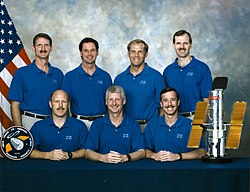STS-82
| Mission emblem | |||
|---|---|---|---|

|
|||
| Mission dates | |||
| Mission: | STS-82 | ||
| COSPAR-ID : | 1997-004A | ||
| Crew: | 7th | ||
| Begin: | February 11, 1997, 08:55:17 UTC | ||
| Starting place: | Kennedy Space Center , LC-39A | ||
| Space station: | Hubble | ||
| Landing: | February 21, 1997, 08:32:26 UTC | ||
| Landing place: | Kennedy Space Center, Lane 15 | ||
| Flight duration: | 9d 23h 37m 9s | ||
| Earth orbits: | 150 | ||
| Rotation time : | 95.2 min | ||
| Apogee : | 574 km | ||
| Perigee : | 475 km | ||
| Covered track: | 6.5 million km | ||
| Team photo | |||
 v. l. No. Joseph Tanner, Kenneth Duane Bowersox, Gregory Harbaugh, Steven Hawley, Mark Lee, Scott Horowitz, Steven Smith |
|||
| ◄ Before / After ► | |||
|
|||
STS-82 ( english S pace T ransportation S ystem) is a mission designation for the US Space Shuttle Discovery ( OV -103) of NASA . The launch took place on February 11, 1997. It was the second maintenance mission for the Hubble space telescope , the 82nd space shuttle mission and the 22nd flight of the space shuttle Discovery.
team
- Kenneth Bowersox (4th space flight), commander
- Scott Horowitz (2nd space flight), pilot
- Mark Lee (4th Spaceflight), Mission Specialist
- Steven Hawley (4th Space Flight), Mission Specialist
- Gregory Harbaugh (4th spaceflight), mission specialist
- Steven Smith (2nd spaceflight), Mission Specialist
- Joseph Tanner (2nd space flight), mission specialist
Mission description
On five spacecraft missions , the American astronauts on the space shuttle Discovery updated the Hubble Space Telescope (HST) , which was captured on February 13 with the manipulator arm of the space shuttle and anchored in its cargo bay.
When Lee and Smith first got out on February 14th (6 hours, 42 minutes), two scientific spectrographs , the Goddard High Resolution Spectrograph and the Faint Object Spectrograph, were replaced with two new devices. NICMOS ( Near Infrared Camera and Multi-Object Spectrometer ) is an infrared spectrometer for the simultaneous analysis of several or large objects, the coolant supply of which should last for four to five years. STIS ( Space Telescope Imaging Spectrograph ), on the other hand, is a 2D camera spectrograph . Both devices have the dimensions of telephone booths. For installation and removal, an astronaut stood on a platform at the end of the manipulator arm, grabbed the device and slowly pulled it out of the device section of the HST. Then the manipulator was moved in such a way that the device could be pushed into a storage container provided for it in the payload bay of the Discovery.
On February 15, Harbaugh and Tanner got out of the Discovery for 7 hours and 27 minutes and replaced a high-precision optical control sensor, some of the associated control electronics ( Optical Control Electronics Enhancement Kit ) and a magnetic tape recorder for scientific data. During their work, the astronauts found damage to the thermal insulation of the telescope . That is why it was decided the following day to carry out another spacecraft operation in order to largely repair this damage.
The third exit (Lee and Smith for 7 hours and 11 minutes) was on February 16. First a data exchange unit was renewed and then a data recorder working with a magnetic tape was replaced by an electronic recorder ( solid state recorder ) that can record and play back at the same time. In addition, a defective gyroscope unit was replaced with a new one. The HST has four such gyroscopes with which it is possible to align the telescope in space with high precision. Each so-called reaction wheel assembly consists of several individual disks that rotate at high speed and thus provide a relevant torque for changing the position of the satellite. If the axis of rotation of the gyro system is shifted, the entire satellite rotates relatively slowly to another position due to its high mass. By resetting the gyro axis, the rotation is stopped in the desired position. Such a gyroscope system does not require any fuel. Only electrical energy is required to maintain the rotation . This comes from the solar cells of the space telescope.
The main task of the fourth exit on February 17th (Harbaugh and Tanner for 6 hours, 34 minutes) was to replace an electronic unit that controls the solar cell panels ( Solar Array Drive Electronics ). With this control, the solar cells are always optimally aligned with the sun in order to achieve a maximum of electrical energy. Covers over several magnetometers were also replaced . In addition, a multi-layer protection was attached to two places with damaged insulation, which were located at the top of the telescope.
At the fifth, additionally scheduled, exit on February 18 (5 hours, 17 minutes), several thermally insulating covers were attached to the device section of the telescope. At the end of this extra-vehicular activity , the astronauts had spent a total of 33 hours and 11 minutes in free space.
During the mission, the orbit of the HST with the shuttle's engines was raised by about 15 kilometers. On the morning of February 19, the bus-sized satellite was released into space again. The Discovery landed in Florida after a successful flight.
See also
Web links
- NASA Mission overview (English)
- Video summary with comments of the crew (English)
- Mission summary of NASA (English)
- NASA video of Mission (English)


